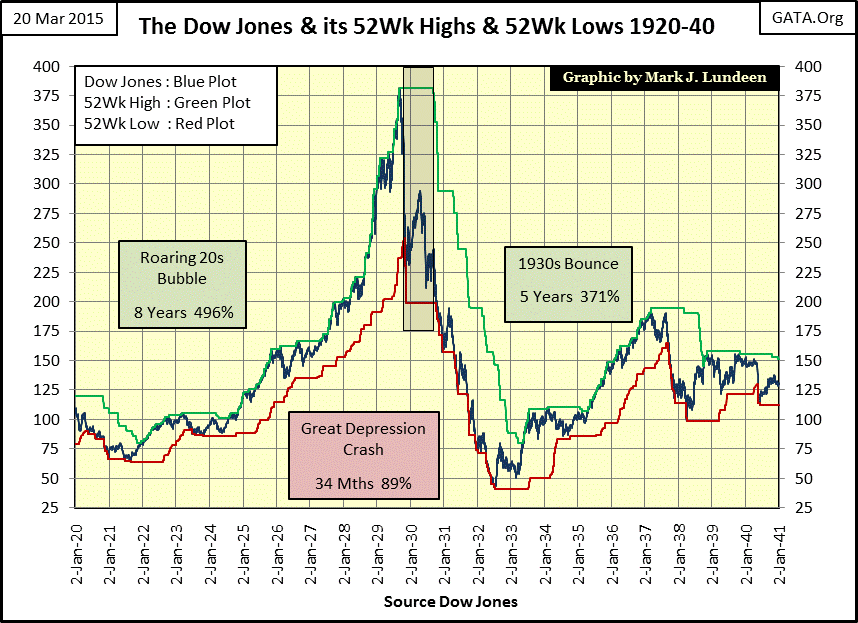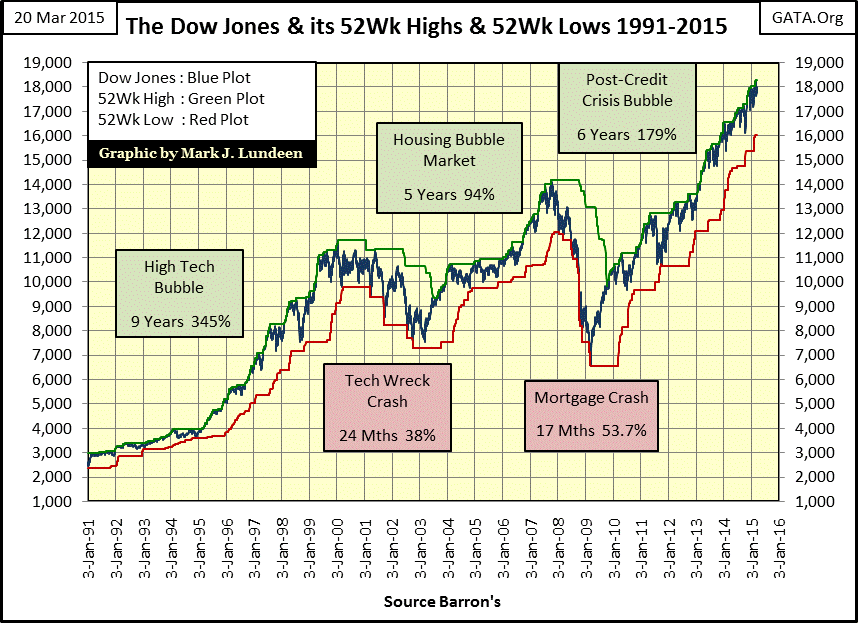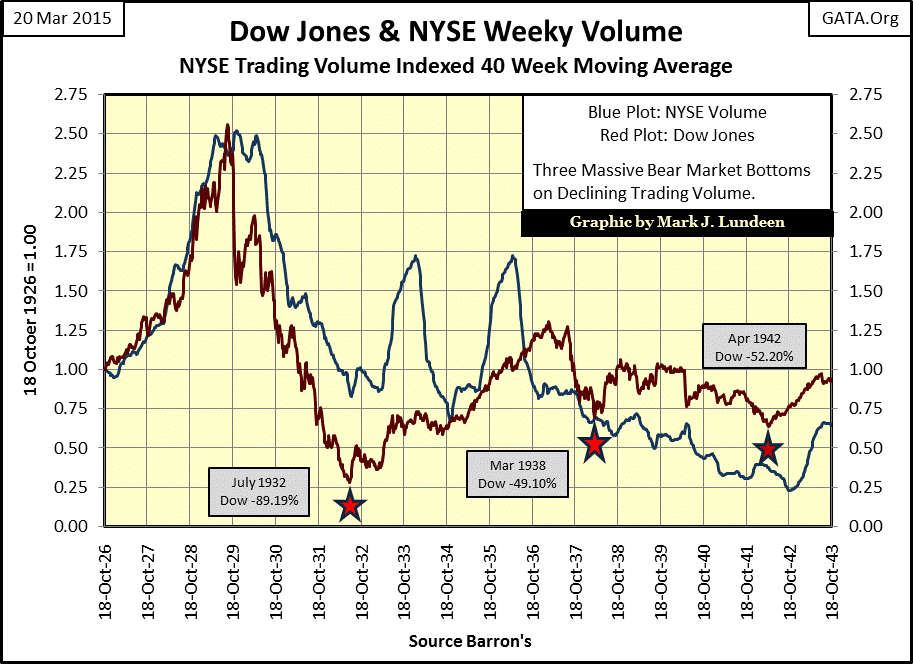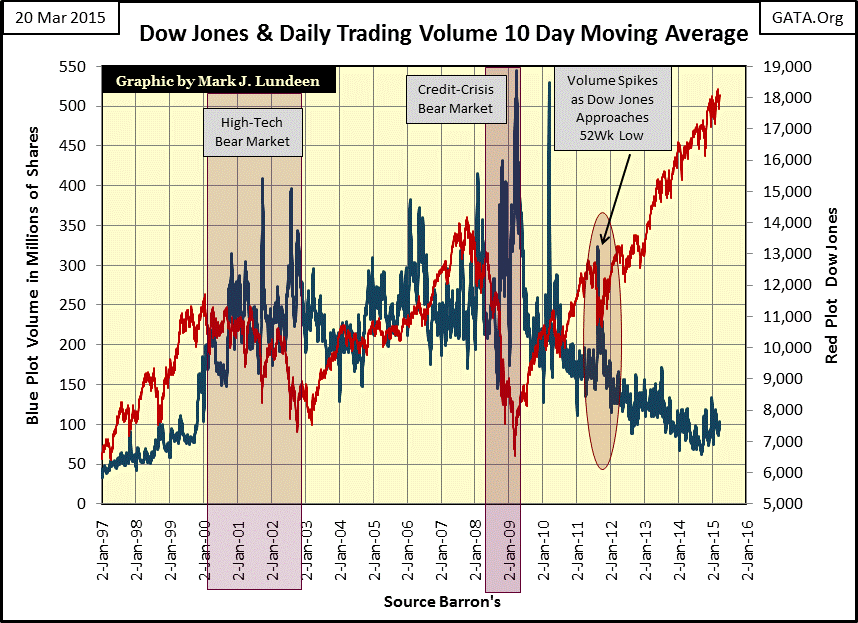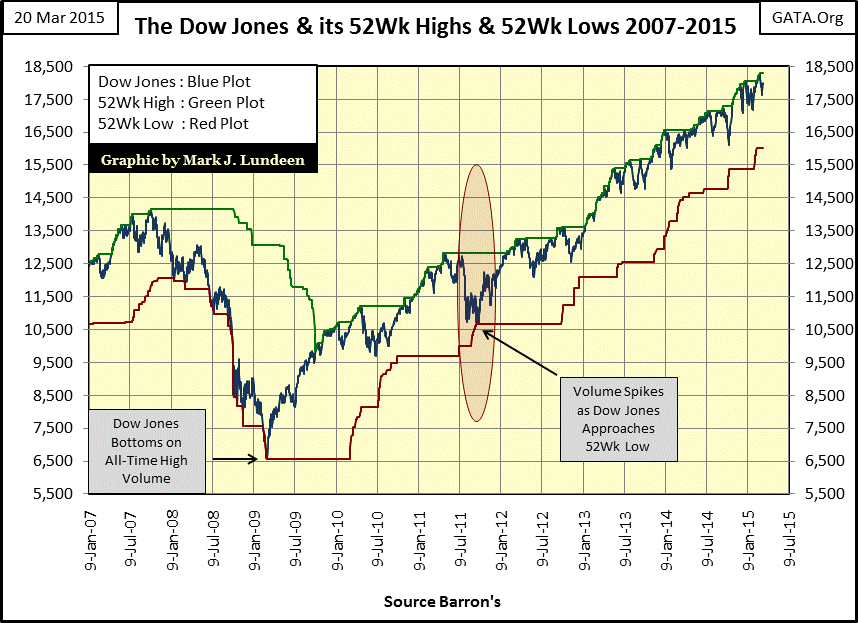The Dow Jones and its 52Wk Highs & 52Wk Lows
When one looks at the daily or weekly NYSE or NASDAQ breadth statistics on the financial pages, publishers always list the number of 52-Week Highs and Lows made during the day or week, and it’s good data. Major indexes also make 52Wk Highs and Lows, but what do they look like, or maybe a better question is how best to plot them? For the Dow Jones I use the venerable index itself, as seen below where I’ve plotted the Dow Jones (Blue Plot) with its 52Wk Highs (Green Plot) and Lows (Red Plot) from 1920 through 1940.
During bull markets the Dow Jones 52Wk highs climb upward as its 52Wk Lows follow, but lagging 52 weeks behind. During bear Markets the Dow Jones 52Wk lows plunge lower with its 52Wk highs following but lagging by 52 weeks. Notably, during the twenty years plotted in the chart, the Dow Jones is usually making regular new 52Wk Highs or 52Wk Lows. However there are periods when the Dow Jones goes for many months without making a new 52Wk High or Low, as we see in the box spanning November 1929 to September 1930, the early months of the crash. Something similar happened from 1923 – 24 when for almost a year the Dow Jones was range bound between 85 & 105, and a few more times, mostly after 1938.
No doubt about it, the twenty years shown above are two decades of important market history, but our most recent two decades have also made history; let’s take a look at them below. With the Dow Jones now around 18,000 the first thing to notice is how bloated the current Dow Jones valuation is. The entire Great Depression crash (-89%) was an agonizing 329 point decline over a period of thirty-four months. Keep that in mind as you read the following quote from CNN Money:
“The Federal Reserve has run out of patience and Wall Street couldn't be happier.
Stocks surged after the Fed's latest statement was released Wednesday afternoon. The Dow was deep in loss territory and then jumped over 300 points in a matter of minutes. The index ended the day up 227 points and back above 18,000.”
- CNN Money: Mar 18, 2015 (Comments on the FOMC removing the word “patience” from its public statement)
Today, in 2015, the Dow Jones moves hundreds of points in a matter of minutes. Nine decades ago a move this large would have taken years. You can thank the Fed (and its monetary inflation) for that.
The Federal Reserve’s “monetary policy” is responsible for the vicious boom / bust cycles seen below. The first two booms have already crashed:
- High Tech Stocks
- Mortgage
The high-tech bubble saw the Dow Jones decline by 38% and the mortgage bubble resulted in a 53.7% decline, the second deepest percentage decline the Dow Jones had experienced since 1885. If Congress hadn’t granted then Treasury Secretary Hank Paulson his “policy bazooka” to blast the dragon of deflation in October 2008, the resulting crash in the Dow Jones would have rivaled, if not exceeded that of its Great Depression decline.
But the stock market crash of 2007-09, as bad as it was, was only a side show to the real action in the credit markets, where inflation flowing from the Federal Reserve found its way into $250,000 subprime mortgages for households with no visible means of support. We can, and should place much responsibility for this with the banking system, and of course Alan Greenspan.
"Innovation has brought about a multitude of new products, such as subprime loans and niche credit programs for immigrants. With these advances in technology, lenders have taken advantage of credit-scoring models and other techniques for efficiently extending credit to a broader spectrum of consumers. These improvements have led to rapid growth in subprime mortgage lending . . . fostering constructive innovation that is both responsive to market demand and beneficial to consumers."
- Alan Greenspan (At the Federal Reserve System’s Fourth Annual Community Affairs Research Conference, Wash D.C. April 8, 2005
But none of this malpractice in credit would have been possible without decades of “affordable housing” legislation and the deconstruction of depression era banking regulation signed into law during the Clinton Administration. The Glass-Steagall Act of 1933 had effectively prohibited any one financial institution from acting as any combination of an investment/security firm, a commercial bank and an insurance brokerage. Then in 1999, congress repealed this protection after 66 years (with the Gramm–Leach–Bliley Act), allowing the crossing of lines and pumping of bubbles.
Also back in the 1990s Barack Obama (as a community organizer) was successfully forcing Citibank to make subprime mortgages to Chicago’s inner city poor, mortgages which were destined to default.
During the subprime bubble, mortgage originators would write subprime mortgages with rates just above yields for US Treasury bonds by bundling them with credit-default swaps. Wall Street would then sell these junk derivative (AAA-rated) “investments” by the trillions of dollars in the now defunct secondary-mortgage market. Fraudulent activity during the mortgage bubble was so extensive that when the bubble finally popped in 2008, the global banking system actually froze as it upchucked illiquid-nonperforming mortgages by the trillions. What’s surprising isn’t that the Dow Jones declined 54% in March 2009, but that it’s turned around and gained 180% since!
The current Dow Jones gains are incidental to the intended target of central-bank inflation: the global bond and currency markets. In our horribly flawed world bond yields are priced for perfection as central banks internationally use monetary inflation to purchase bonds in volume and at prices no rational money manager ever would in a free market. Central banks are also driving the value of their currencies ever closer to zero by expanding their money supplies to beggar their trading partners. This can’t go on forever, but as long as it does expect both bond yields and interest rates to remain low and the Dow Jones to continue to rise.
Without a doubt the stock market today has changed greatly since the 1920s and 30s, but in some ways not. The Roaring 1920s bull market was financed by cheap credit flowing from the Federal Reserve into margin accounts, where retail investors could leverage a dollar up ten times to invest in hot “growth sectors” like auto manufacturing and electric utilities. NYSE trading volume (Blue Plot below) swelled to record highs, as did the valuation of the Dow Jones (Red Plot) as monetary inflation from the banking system flowed into the stock market. When the bubble popped in October 1929 there was no one standing on the sidelines with his congressionally mandated “policy bazooka” to “stabilize” the stock market, so from 1930-32 NYSE trading volume plunged along with the Dow Jones.
What’s well illustrated above is how the stock market worked during the 20th century; bull markets occurred on rising trading volume as the public entered the market with their money; bear markets saw declining volume as the public exited the market, leaving much of their money behind. But all that changed in 2000 as the high tech bubble began to deflate, as is evident below. Both the high-tech and mortgage bear markets occurred on record or near record trading volume. Bizarrely, since the March 2009 bear market bottom the Dow Jones has advanced 180% as trading volume collapsed. This has never happened before, but never before has the banking system used monetary inflation to force “stability” on a market as they are attempting to do now.
The oval in the chart above and below proves my point. In September 2011 as the Dow Jones approached its 52Wk Low, daily trading volume for the Dow Jones’s 10Day Moving Average spiked from below 200 million shares a day to over 300 million shares. After “stability” was once again imposed on the market in early October 2011, the Dow Jones returned to its uptrend – on declining trading volume.
As long as central banks can maintain their grip on financial markets we should expect more of this financial foolishness in the months, and years to come. However all bull markets eventually reach a point of exhaustion, a point where market bulls (or central banks) can no longer determine the market’s trend. Up until 2000 exhaustion would generally occur on peak trading volume at a bull market’s top. But last week at King World News; Eric Sprott may have pointed to the future where he fears the stock and bond markets as currently managed are destined to become “no bid markets.” This is exactly what we saw happen with the subprime mortgage market in 2007: all sellers and no buyers.
With the gold and silver markets managed as they currently are, don’t be surprised if they become no-offer markets when the bubble finally bursts; all buyers and no sellers.







